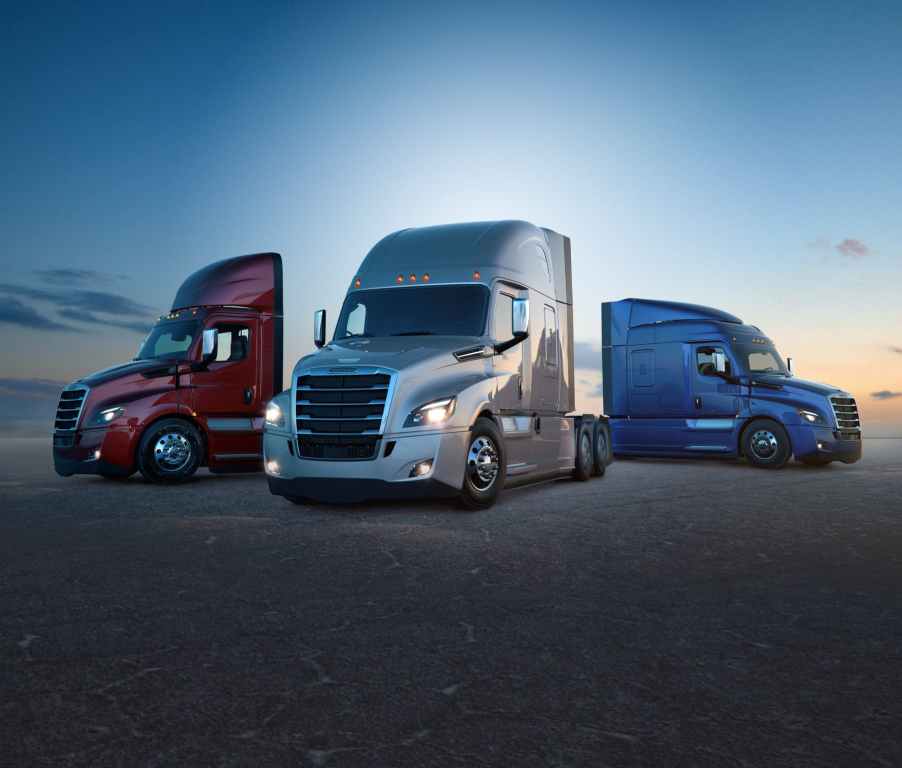
The Most Fuel-Efficient Semi-Trucks Are Absolute Gas Guzzlers
Weighing in at around 80,000 lbs a pop, semi-trucks are far from economical. They need massive engines to make them capable of towing heavy loads, and monstrous gas tanks that’ll keep them on the road for hours. So it should come to you as no surprise that semi-trucks are gas guzzlers. What might surprise you, however, is the kind of fuel-economy the most economical semi-truck on the market drinks.
The Freightliner Cascadia Evolution I gets over 10 mpg
While towing 76,000 lbs, the Freightliner Cascadia Evolution I manages to get 10 mpg. That’s considered economical, since the average semi-truck gets just around 6 mpg. For most regular drivers, going to a racetrack may be the only real way to achieve such a feat.

However, pair that with two 100 gallon tanks (commonplace on most semi-trucks) and you’re looking at over 2,000 miles of range. This is where those extra miles per gallon come into play, as an average semi truck with a combined 200 gallons of gas would only make it 1,200 miles before a fillup. For perspective, 800 miles is about the distance from Orlando Florida to Washington DC.
But how does this hypermiler Evolution I differ from a base model Freightliner Cascadia?
What makes the Evolution I different than the regular Cascadia semi-truck?


I’ve done extensive digging on the subject, reading trucker forums and exploring both the Freightliner and Detroit Diesel websites. But truth be told, the difference between a Cascadia and an Evolution I are minimal. Both trucks use the same Detroit DD15 engine, which is rated at anywhere between 400 and 505 horsepower. The only assumption I can make is that the 400 hp model is more fuel efficient, though at 14.7-liters of displacement, the engines are big either way.
In terms of price, it’s also hard to get an accurate number. There are a thousand ways to spec a truck, starting with whether you need a sleeper cab for overnight hauling, or if you just need a day cab. But on average, a Cascadia semi-truck with a sleeper cab costs about $160,000.
The main difference between a regualr Cascadia and an Evolution I are the little goodies stuffed inside to save fuel. The Evolution I has advanced aerodynamics, as well as tehcnologies inside the engine to reduce idling at night (truckers don’t always shut off the truck, even when they’re at a rest stop).
But these little details help propel a smaller, cabless Cascadia towing 76,000 up to that 10 mpg marker. Which is a number that only a special kind of car can manage.
The Bugatti Chiron Pur Sport is the only other car with such low fuel economy

With a matching fuel economy of 10 mpg, the Bugatti Chiron Pur Sport is the least economical car according to Car and Driver. But in order to achieve that number, the Chiron Pur Sport needed that extra wing on the back. The regular Bugatti Chiron squeaks out 11 mpg without it.
To reach this remarkably low fuel economy, the Chiron Pur Sport is stuffed with an 8-liter W16 engine (that’s four inline engines shaped like the letter W). And with four turbochargers, it makes a staggering 1,500 hp, tripple that of the Freightliner Cascadia Evolution I.
So now you know that the gap between the most economical semi-truck and the least economical truck isn’t that big. What you’ll do with this information, who’s to say? But long story short, Freightliner has done their due dilligence to make the Cascadia the world’s most economical semi-truck.
Next, find out whether Tesla’s electric semi-truck can’t haul anything heavier than potato chips, or see the Freightliner Cascadia Evolution I for yourself in the review below:




